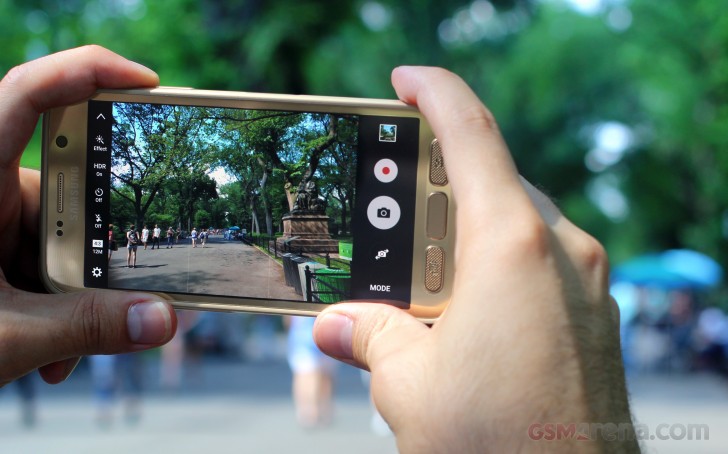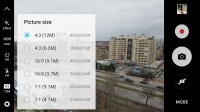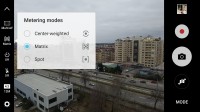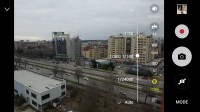Introduction
We're already used to seeing Samsung release an 'Active' version of its current Galaxy S flagship. The Samsung Galaxy S7 active is the latest in the series and it has been released exclusively to AT&T as it's also become customary. If history should serve as any reference, the model would likely not see availability outside the stable of this particular US carrier.

The S7 active has a much larger 4,000mAh battery inside. (by contrast, the Samsung Galaxy S7 has a 3,000mAh battery) Compared to the vanilla S7, there's also the extra physical key on the phone's side which takes you directly to an "Activity Zone" app, which is exclusive to the Active model.
Samsung Galaxy S7 active Key Features
- Built to comply to the MIL-STD-810G standard with increased salt, dust, humidity, rain, vibration, solar radiation, transport, and thermal shock resistance
- IP68 certified - dust proof and water resistant up to 30 minutes in 5 feet of water
- 5.1" Super AMOLED QHD (1440 x 2560) resolution, Gorilla Glass 4, shatter proof for falls of up to 5 feet high onto a flat surface
- Qualcomm Snapdragon 820 - dual-core 2.15 GHz Kyro & dual-core 1.6 GHz Kyro w/ Adreno 530
- 4GB of RAM; 32GB of built-in storage, microSD up to 256GB
- Android 6.0.1 Marshmallow with Touchwiz UI
- 12MP camera, f/1.7 aperture, 1,4micron pixel size, phase-detection diodes at every pixel in the sensor, 4K video recording, LED flash, optical image stabilization
- 5MP front-facing camera, f/1.7 aperture, QHD video, HDR
- Fingerprint sensor
- LTE Cat.9, Wi-Fi a/b/g/n/ac, GPS/GLONASS/Beidou, NFC, IR port, Bluetooth 4.2, ANT+
- Heart-rate sensor, barometer, SpO2 sensor
- 4,000mAh battery ; wireless charging
- FM Radio
Main disadvantages
- Thicker than most of today's flagships (duh!)
- Exclusive to AT&T with lots of carrier bloatware
- No Samsung Gear VR compatibility
Rest assured, we're all wondering for how much longer the Active series will remain an AT&T exclusive. Surely, there are many fans all over the world who would love to get one as an unlocked, carrier-free device without any pre-installed AT&T apps. We have no idea when that may happen but we're surely keeping our fingers crossed.
As for pricing, the premium for the Active model is just $100, which means it costs the same as the Galaxy S7 edge model in the US. So are the added features of the Galaxy S7 active worth this sort of premium? Read on and we'll find out together.


Display
The Galaxy S7 active has the same Super AMOLED 5.1 inch 1440p (1440 x 2560px @~577ppi) as the standard Galaxy S7 does. Colors are vibrant and lines are crisp. Samsung claims the Galaxy S7 active is shatter proof for drops of up to 5 feet high onto flat surface, and it looks like Samsung was able to do it without sacrificing screen quality.
We've performed the same display tests as on the Galaxy S7 to see if the Active version's display performs just as well as the standard model it originates from.

We're happy to see the Galaxy S7 active exceeds our expectations for a display of this kind. The display's assembly uses the same Gorilla Glass 4 as the S7 proper, but the S7 active has a layer of polycarbonate that is invisible to users. This is what provides that extra level of shatter protection that has been proven to work and can be seen in various videos on the interwebs.
We are happy to report that this display is even brighter than the S7's panel. On top of that, the screen goes into overdrive when exposed to even brighter sunlight as long as you have the Auto brightness ticked ON.
The same S7 active panel goes just about as dim as the Galaxy S7 at 2.3 nits. Night owls who like to do some late night activity will be happy to know they won't be blinded by the screen at night.
| Display test | 100% brightness | ||
| Black, cd/m2 | White, cd/m2 | ||
| 0.00 | 424 | ∞ | |
| 0.00 | 602 | ∞ | |
| 0.00 | 391 | ∞ | |
| 0.00 | 563 | ∞ | |
| 0.00 | 363 | ∞ | |
| 0.00 | 619 | ∞ | |
| 0.29 | 428 | 1543 | |
| 0.17 | 306 | 1855 | |
| 0.20 | 378 | 1881 | |
| 0.36 | 536 | 1481 | |
| 0.39 | 595 | 1526 | |
| 0.33 | 482 | 1461 | |
As far as color accuracy goes, the GalaxyS7 active (much like the S7) is most accurate when using the Basic profile under the display settings. While these colors look more washed out than the default Adaptive profile, they are better representative of real-life colors. The Average Delta E comes out to just 1.2 where the Adaptive profile produces an average Delta E of 5.
Connectivity
Just because the Galaxy S7 active is an AT&T excusive device, doesn't mean it's missing too many LTE bands. The device runs on AT&T's LTE network and is compatible with its VoLTE network. It supports LTE bands: 1(2100), 2(1900), 3(1800), 4(1700/2100), 5(850), 7(2600), 8(900), 12(700), 20(800), 29(700), 30(2300), 38(2600), 39(1900), 40(2300), 41(2500). AT&T's bands are shown in bold.
GSM 850, 900, 1800, and 1900 are supported while the S7 active's 3G bands are HSDPA 850, 1900, and 2100. HSPA speeds reach theoretical 42.2Mbps download speeds and 5.76Mbps upload speeds. LTE speeds are Cat9 @ 450Mbps down and 50 Mbps up.
The SIM card tray accepts one nano-SIM card and one microSD card up to 256GB. To save space, the SIM/SD slot was designed with two sides and caught us off guard at first. Pulling the tray out, we expected it to be a long one with two spaces, rather, the tray is like a coin. Two-sided, the microSD card goes on the front side of the tray and the nano-SIM on the rear side.
Other connections include Bluetooth 4.2 (A2DP, LE, aptX), Wi-Fi 802.11 a/b/g/n/ac dual-band, Wi-Fi Direct, hotspot, GPS with A-GPS GLONASS, NFC, FM Radio, and uses a microUSB 2.0 QuickCharge 2.0, and OTG support.
Battery life
The Galaxy S7 active has a whopping 33% larger battery over the vanilla S7 model (4,000mAh vs 3,000mAh). The Galaxy S active models have traditionally had larger batteries over their regular models which Samsung believes is necessary for the active consumer. The Galaxy S7 active is surely going to last you, a long time.
Samsung didn't skip out on quick-wireless charging for the active model, and it also features Quick charge 2.0. From a completely depleted battery, the Galaxy S7 charged up from 0% to 37% in 30 minutes. Keep in mind this is a larger capacity battery, so older claims of half battery in half an hour are further out of reality's reach.

While the Galaxy S6 active broke the 100h mark in our battery scores last year, this isn't necessarily the case with the S7 active this year despite the bigger battery. If Samsung chose to opt for the Exynos 8890 CPU all across the board (as North American variants of the S7 are all powered by the Snapdragon 820), it may have been able to beat last year's S6 active score of a whopping 109h overall.
The Galaxy S7 active scored 96h overall, which is still quite impressive. By contrast, the Galaxy S7 (Exynos 8890 variant) scored 80h overall in the same battery tests. Always-On Display is enabled by default, which knocks the score down to 70h overall. Since its launch, the AOD setting has been optimized and now allows you to schedule times to activate it. Of course, your mileage will vary depending on how long you keep the phone out of your pocket and whether you have the feature on to begin with.
Like the S7, our browsing test scored significantly lower than the video test. While the 12:08h score of the web browser was not up to par, the video playback test scored an impressive 20:54h! The S7 active merely sipped juice when playing a locally stored video from its storage.
In our calling test, the Galaxy S7 active scored 29:17h, the highest phone call endurance of any of the other S7 variants across both Exynos and Snapdragon variants.
Our proprietary rating denotes the number of hours the phone will be operational if you are to make an hour of 3G talks, web browsing and video playback per day. Such usage pattern may not apply to you directly, but we've established it so our battery results are comparable across devices.
The proprietary score also includes a standby battery draw test, which is not featured in our battery test scorecard but is calculated in the total endurance rating. Our battery testing procedure is described in detail in case you want to learn more about it. You can also check out our complete battery test table, where you can see how all of the smartphones we've tested will compare under your own typical use.


Synthetic benchmarks
Unlike the global version (using Samsung's own Exynos silicon), the Galaxy S7 active is powered by the latest Qualcomm Snapdragon 820 CPU (as are all North American variants) paired with 4GB of RAM. The Snapdragon 820 features two dual-core Kryo chips. The first is a dual-core chip which maxes out at 2.15 GHz and the second dual-core chip maxes out at 1.6 GHz.
The Snapdragon 820 is Qualcomm's first departure from 8 cores down to quad-core territory, don't be fooled by that number though, a single Kryo core is a beast and what separates it from previous Snapdragon chips is its new architecture which combines improved efficiency with overall better performance.

A generous 4GB of RAM and the Adreno 530 GPU joins the Snapdragon 820 to give the S7 active a great deal of performance power under all that rugged exterior.
Let's see how the S7 active performed against other top competitors. Since the S7 active is only available in the US, we're going with mostly high-profile flagships available in the US.
For starters, the Galaxy S7 active's single core performance fits right in among the other Snapdragon 820 devices on the market. Still, the iPhone 6S' A9 chip dominates this chart in single core calculations.
GeekBench 3 (single-core)
Higher is better
Here is where we can see the raw calculating power of the global Galaxy S7's Exynos CPU. Much like the single core test, we can see the Galaxy S7 active fall right among the other phones fitted with a Snapdragon 820. Here we also get a glimpse of how the quad-core 820 fared against the octa-core Exynos 7420. While there is a bit of an improvement, it's not too significant.
GeekBench 3 (multi-core)
Higher is better
The Galaxy S7 active falls average among the other Snapdragon 820-powered smartphones of the bunch. Antutu 6 is a compound benchmark that takes into account all aspects of the system as opposed to just raw CPU processing. A combination of factors like optimization and tuning contribute to the Antutu 6 marks, and the Galaxy S7 active is beaten by the OnePlus 3 and HTC 10, which topped this chart.
AnTuTu 6
Higher is better
For our Basemark OS II 2.0 test, we can see the Galaxy S7 active reaching high above the other flagships.
Even with the Galaxy S7 active having the same setup as some of the other flagships, it looks like Samsung's RAM optimization and CPU thresholds set it up well for this particular benchmark.
Basemark OS 2.0
Higher is better
GFXBench is an OpenGL ES 3.1 test which measures graphics performance, and the offscreen tests run at 1080p resolution, regardless of the pixel count found on the display of the device being tested, giving all graphics tests an even playing field. The Galaxy S7 active performed at the top, although most devices on the list scored 30 or 31.
GFX 3.1 Manhattan (1080p offscreen)
Higher is better
The next test runs in the phones' native resolutions and those with higher-res displays are pulled back by the benchmark numbers. Since the OnePlus 3 and Xperia X Performance both run 1080p resolutions on their displays, they get about twice the score as the competing QHD resolution phones. The Galaxy Note5 stuck behind with last year's Exynos setup.
GFX 3.1 Manhattan (onscreen)
Higher is better
The GFX Car scene is round-two for the flagships to duke out graphic performance. The offscreen tests (also rendered at 1080p) score significantly lower than the Manhattan tests since the car scene turns the knob up a notch. The S7 active topped the chart along with the HTC 10 and OnePlus 3. Meanwhile, the Galaxy S7 with Exynos hovers around the bottom.
GFX 3.1 Car scene (offscreen)
Higher is better
Much like the Manhattan test, the Galaxy S7 active's onscreen test is pulled down by its native QHD resolution. Still, it performed at the top of its class with other QHD phones that run the same Snapdragon 820 setup, and it performed better than the Exynos-powered global S7.
GFX 3.1 Car scene (onscreen)
Higher is better
Basemark X is a benchmark which lets us gauge how they are performing with the other contenders of the bunch in the gaming aspect. The S7 active scored well around other Snapdragon 820-powered phones and performed quite similarly to the Exynos-powered S7. Samsung did a great job of leveling the performance of both chipsets.
Basemark X
Higher is better
Basemark ES 3.1 offers a testing field for OpenGL ES 3.1 compatible devices that aren't necessarily on the same platform, namely: iOS and Android. The Metal Basemark for iOS gives us an idea of where the two platforms stand relative to each other.
The Galaxy S7 (Exynos) scored notably higher than the S7 active and the other Snapdragon 820 devices as well. The iPhone 6S still reigns this test although it's really hard to compare Apples to Androids in these kinds of tests.
Basemark ES 3.1 / Metal
Higher is better
It's worth noting that the Galaxy S7 active dissipates heat differently than any of the other flagships out this year. Since the back plate of the S7 active is made of polycarbonate, it's not such a good heat conductor like glass or metal. The S7 active has to depend on its sides to dissipate heat. When performing CPU or radio intensive tasks, the upper-right side is the one which gets quite warm, though, not uncomfortably warm.
The Galaxy S7 active performs just as well if not better than the other flagships powered by a similar Snapdragon 820 setup. Day to day activities run like cake and the generous 4GB of RAM ensure that you're much less likely to have a slow phone upon switching back and forth between apps.
Remember, the Galaxy S7 active is also a result of Samsung pushing out CPU optimizations and updates over the past few months since the release of the Galaxy S7 (Snapdragon variant in North America) and other Snapdragon 820 devices which were reviewed with initial versions of public firmware.
Camera
If you've been familiar with Samsung's camera interface from the last year or so, you won't find many surprises in the Galaxy S7 active. It also sports the same 12MP F/1.7 camera as the Galaxy S7. To be even more specific, our unit has the SONY IMX260 camera sensor and not the Samsung-made ISOCELL S5K2L1.

While there are some minor differences between the two sensors, they both perform equally well. Both have relatively large 1.4-micron pixels, and each pixel is in a dual-pixel setup meaning a phase detection subpixel joins it. As a result, the phone focuses and re-focuses instantly regardless whether you're shooting video or capturing photos - it's perhaps the fastest focusing cameraphone on the market right now.
Camera interface
The camera app is almost entirely the same as the one on the phone being replaced. It has a combined interface for stills and video, with virtual shutter release and record button on the one side and quick settings on the other. A few minor touches include an extra setting for resolution and a universally recognizable red dot symbol on the video record button instead of the more ambiguous video camera on older models.
Motion photo is available, too, it captures a three-second video before you've pressed the shutter and embeds it within the .jpg file. Since the initial launch of the S7 and S7 edge, it was difficult to share these motion photos to other users who don't have an S7. Thankfully, a Samsung update has since allowed users to export these motion photos as standard videos to share to others. Though, we wish there was a better way to share them.
Pro mode gives you more photographic control and offers manual control of shutter speed, exposure compensation, ISO sensitivity, and white balance. Manual focus is also available, and the S7 active magnifies the center portion of the viewfinder, allowing you to have a better look at what you're focusing on.
The Galaxy S7 active provides excellent image quality with plenty of detail and sharpness with acceptable traces of noise here and there. More importantly, the Galaxy S7 active keeps the same great camera, proving that the 12MP sensor is an all-around performer for people of all kinds of lifestyles.
Here are some comparison shots taken with the HTC 10 as well.
HDR in some cases can make or break a photo. In cases where there may not be enough light to expose the photo properly, HDR can really bring out the shadows and bring the photo back to life. The best example can be seen here at the picture taken on 8th Avenue just about 10 minutes before the sunset. The resulting image still manages to look natural.
Really pushing the exposure in the 8th Avenue scene results in noisier details and textures. Still, the photo would look great when resized on social media.
Here is an HDR scene from the HTC 10 for comparison.
Once lighting starts to get really dark, more into the nighttime territory, even HDR is not able to save the photo. You'd have to rely on a steady hand and setting the correct exposure in order to capture the best possible shots. Here are some shots taken just after the sun went down. The rainy weather reflected the city's light pollution right back into the city.
Keep in mind that scenes like this are harder to capture completely in focus with a smartphone. Look out for the point of focus as this is where you'll be able to make out the details of the buildings. The first scene's focus is in the nearest building, the second one is at the top of the Metlife building, and the focus at Grand Central is found along the kiosk.
The Galaxy S7 excels at panoramas too. When holding the phone in portrait the images can be as tall as 4,032 pixels in vertical resolution minus whatever cropping it needs to do to compensate for your tilting and moving the camera vertically.
The Galaxy S7 active does well with panoramas as well. Even so, it's able to blend different exposures well in cases where you'd like to capture a scene that might include the sun.
5MP selfie camera
Image quality from the front camera is more or less the same as the predecessor. It can't handle high-contrast scenes terribly well and blows out the highlights, but in all fairness, that scene would challenge a primary camera as well. More balanced lighting produces better results, and in any case skin tones are rendered in a very pleasing true-to-life way.
The Galaxy S7 active has the same 5MP camera found in the Galaxy S7. We still took it out for some selfie action.
Video
Befitting its flagship nature, the Galaxy S7 active can capture video in 4K (2160p/30fps), 1080p/60fps, 1080p/30fps, as well as the less common 1440p/30fps and lesser resolutions. From the shooting modes you can select slow motion video (720p/240fps), and Hyperlapse. The latter has fixed speeds ranging from 4x to 32x, plus an Auto mode, where the S7 active analyzes footage and uses a variable speed depending on the action taking place.
4K videos are recorded with a bitrate of 48Mbps, 1080p/60fps are 28Mbps, while regular speed 1080p/30fps get 17Mbps. Either way audio is recorded in stereo at 256Kbps, so no complaints on the numbers.
None when it comes to video quality either. 2160p videos are packed with detail, you can extract frames and have them pass as an 8MP photo, almost. Color reproduction is the same as still images, saturation neither drops, nor is additionally pumped up.
We took some video samples in two types of scenes, moving scenery, and moving camera. This way you can see how the different camera modes record in different situations. We've put the stabilization tests in a playlist below so you can watch the videos back to back. As always, you can also download video samples in the following links: 1080p @ 30fps / 1080p @ 60fps / 2160p (4K) @ 30fps.








































